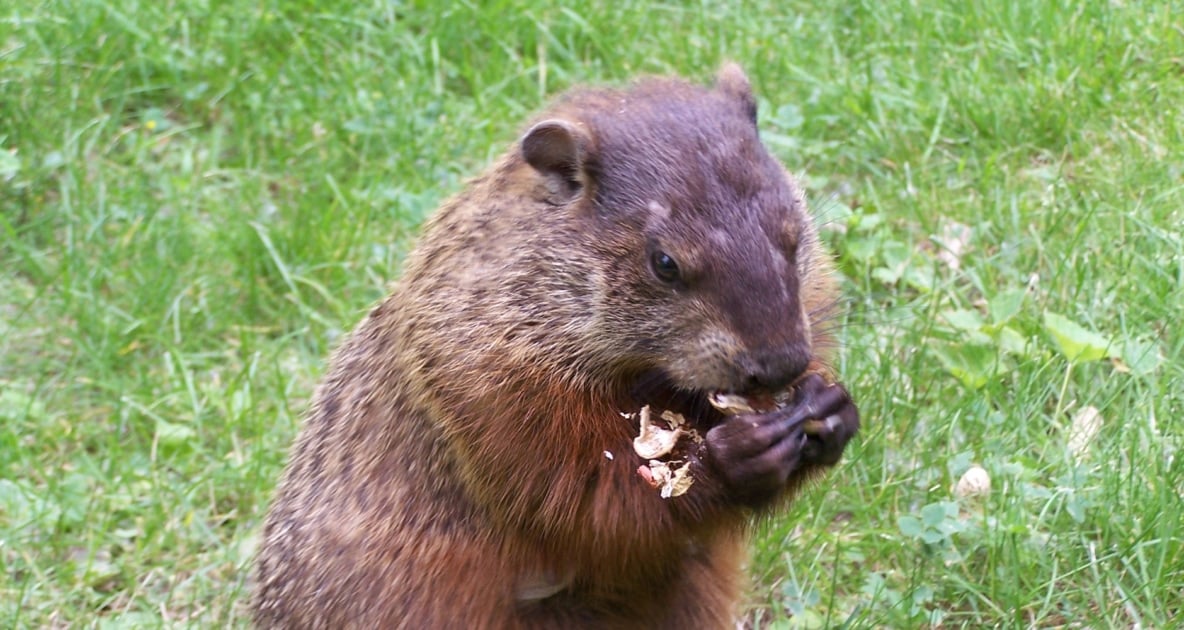Garden Pests: Groundhogs
Groundhogs are cute, but they can be destructive to your lawn and garden. Learn a few tips to send them packing!

Wild animals are part of what makes nature so magical, and watching them can be highly enjoyable. While it’s important to coexist with animals in relative peace, they can cause countless problems when they take up residence in our homes or gardens. In this series, our Wildlife Management Specialist, Shawn Weeks, will educate us about some common household pests, and share some strategies for keeping them under control without dangerous chemicals or poisons.
Habitat and History
Groundhogs — also known as woodchucks, whistle pigs, or marmots — are stocky mammals with strong, short legs and short bushy tails. Their fur ranges from dark to light brown with very light guard hairs, making them sometimes look frosted. Their front feet have long, curved claws used for digging burrows. Groundhogs generally weigh between five and ten pounds, and males are usually slightly larger than females.
Groundhogs range from eastern Alaska through most of Canada and the eastern United States, as far south as Georgia. They are, for the most part, absent west of the Great Plains, though their close relative, the prairie dog, ranges farther to the west. Groundhogs are classified as rodents and are related to animals such as mice, porcupines, squirrels, and beavers.
Groundhogs are also excellent diggers with dens ranging from simple and shallow dwellings, to extensive tunnel systems twenty-five to thirty feet long, and two to five feet deep, with two entrances. Their nesting chamber is usually at the end of the main tunnel, and they also make a toilet chamber somewhere within the tunnel system, helping to keep their living space clean.
Groundhogs seldom venture more than a few hundred yards from their burrows. They have a keen sense of smell and hearing, helping to keep them safe from predators. They are also fierce fighters and can hold their own against their enemies, which include humans, dogs, coyotes, foxes, bears, bobcats, mink, hawks, weasels, and owls. Groundhogs will also emit a loud whistle or shrill when startled or frightened (thus their nickname, “whistle pig”), then continue on with a “chuck chuck” type of chatter until they settle.
During pre-colonial times, groundhogs lived in forested areas. Once the land was cleared for farms and towns, they moved to fields and “edge” — the border between a forest and town. They are found throughout many suburban areas where edge is common. They are very adaptable mammals.
This fascinating mammal is also a true hibernator. They fatten up for the winter, gorging themselves as best as they can each fall. Once winter temperatures begin, they enter their sleeping chamber, shut down their metabolism and begin their long sleep.
Diet
Grasses and forbs are the primary diet of groundhogs, making them true herbivores. Forbs are any plants other than grass with growth that dies back after flowering and seeds set. They will also eat things such as fruit, tree leaves, garden vegetables, clover, and alfalfa.
Reproduction
As a general rule, groundhogs breed in their second season, although some have been known to breed as yearlings. They breed in March or April, and a litter of two to six young that are born about a month later. Groundhogs grow, and are weaned, at a very fast pace and will seek out their own den and range by mid-summer. They are born blind, naked, and helpless.
Problems, Solutions and Health Concerns
Groundhogs can cause major damage to farmers and home gardeners. They love to eat vegetables and leave the soil weak in areas where they burrow, resulting in damage to farm equipment and injuries to horses and livestock. In extreme cases, groundhog burrows have even been known to damage the foundations of barns, garages, or homes.
Rabies can also be a concern for people who have groundhogs on their property. They are mammals, making them susceptible to the disease.
There are a few solutions available to folks who are having a problem with groundhogs. Installing a wire mesh fence can deter groundhogs from browsing your gardens and crops. You must, however, make the fence extend down into the ground at least two feet. Because groundhogs are excellent diggers, installing a simple fence from the ground up may not do the trick. You should also extend a one-foot, angled section from the top of the fence. Some groundhogs have been observed climbing short, vertical fences.
Ammonia soaked rags are another good groundhog deterrent. Groundhogs will mistake the ammonia for a predator’s urine, and will steer clear of your property. Place the rags close enough to your garden that the groundhog can smell them, but not so close that the ammonia will leach into the soil around your crops. A few feet from the perimeter of your garden is a good rule of thumb. If you’re worried about the ammonia burning your lawn, you can place them on pieces of wood. If you have a cat, used kitty litter will serve the same purpose.
If all else fails, you can also live trap and remove groundhogs from your property. Always check with your state wildlife agency before relocating any animals from your property. There may be laws in your area prohibiting you from doing so. Relocating groundhogs is illegal in some states, due in part to fears of spreading rabies.
See some of these other natural ways to keep groundhogs out of your garden!

Shawn Weeks
Shawn is a lifelong New Englander. He lives in Canton, Conn., with his wife Tami, mother, sister, and her three children. He and his wife have two grown children and two grandchildren. Shawn is an avid hunter, fisherman, and gardener. He is also a writer, a nuisance wildlife professional, small scale farmer, and scout leader. You can email him at [email protected].






I have a Groundhog that used to live in my Garden we used to have overgrown trees and bushes. Since we cut down trees cleared shrubs. Put up a fence dug up his hole. Now He comes over from the empty house in our back your .He was going after my little trees I put Cheyenne pepper around them and marigolds seems to be leaving them alone . I just put lime down across perimeter of fence will that help
I live in Nebraska and it’s illegal to trap the woodchucks and you will be fined if you do. I have them under my shed, with two holes. The Humane Society told me to put down cans filled with with soapy ammonia or regular ammonia with holes in the lids around the holes. After 3 days lay down a thick layer of hay.If it isn’t disturbed you know the woodchucks have left, if not you have to repeat the process. I’m pretty sure the hay method would let you know if any your natural methods had worked. I don’t yet because I just literally just gone done talking to them and it is supposed to rain tomorrow. I will also try some of the other methods also if this fails. I will let you know if I have luck with this
Did the ammonia work for you?
I bought 8 gallons of ammonia. I got a gallon jug,and mixed the ammonia to hot water 50% – 50%. I needed to pour the mixture along the side of my garage because they had burrowed under the cement foundation. I knew, because of the time of the year, that there was a litter of young groundhogs too. So I mixed two gallons of ammonia with hot water, and shook the jug for 30 seconds.I got down on my knees, behind a hummingbird bush, and crawled along the foundation. Boy, is was strong! I emptied two gallons day one, waited a day, repeated on day 3, waited a day, and hit it a fourth time on day five. I haven’t seen one groundhog in a week. I know they’re gone because I always saw them in the early A.M. and early evening. This really works. To make sure they didn’t come back, I found urinal cakes at WalMart for $0.47 each. I bought two dozen. I put them every six inches under the foundation. And for good measure, a few inside the garage near the wall where they had burrowed outside. Other than a slight smell in the garage ( not bad at all ) this REALLY works. I may have all of $10.00 in this, but they aren’t coming back here.
A groundhog climbed, yes I said climb my 5′ garden fence last year to eat my prized cantalopes. These creatures serve no purpose for existing except to destroy all that is good in nature.
God don’t make mistakes
Laura, we’ve had the same issue, they are living under our porch, tunneled under a deep fence and chopped my crops, and eat my flowers. We’ve tried Shake Away and Animal-B-Gone with initial success but you have to reapply. If they’re really hungry or if they figured out its not real (I swear) it doesn’t help honestly. We live trapped 3 and it had been 3-4 since we saw the others. The remaining 2 we knew of just reared their oddly cute heads. Live trapping and harassment has honestly been the most effective for us so far.
Please please help ! We have ground hogs completely taking over our property they are under are porch n carriage house. Our home is over 130 yrs we have tried trapping them but they just come back . They are destroying everything ! Our pest control guy has suggested fox urine does it really help ? We are willing to try anything!
At night, burn sulfur sticks into their holes and cover them, everything inside dies, nothing comes back.
I was wondering if rock chucks are dangerous to other small animals? We have rabbits in a pen outside and we have noticed the local rock chucks have been trying to get into their pen. Will they kill our rabbits?
I know it’s not politically correct to advocate this approach, but the only easy and sure fire way to get rid of them, is to pour concrete in their burrows. Go to the hardware store, get some mix and be done with it. Yes – they are living creatures….. so what? So are chickens, cows and pigs. We kill them, don’t we? So are mice and rats. Most people don’t feel guilty about exterminating them.
Why would you torture them?
If you’re gonna kill them, at least shoot it so it doesn’t get cemented, starve, injured etc…
Wtf
Please consider a more humane approach. While other animals are killed, it’s usually quick.
I use a 22 mag rifle. Works great. My neighbor eats them.
Lol eeewww
I spotted my first ground hog in my fenced back yard. We we went out to see we’re it went . Sooo I have two gardens chicken wired under and around. I don’t want it around. Any suggestions
Hi,
We found a groundhog and put a trap for him we caught him and decided to put him away from us. Would y’all think that’ll work? How many miles far do we have to take him?
Hi Sandy, we say “Always check with your state wildlife agency before relocating any animals from your property. There may be laws in your area prohibiting you from doing so. Relocating groundhogs is illegal in some states, due in part to fears of spreading rabies.” You might want to check with them about what a safe distance is, depending on where you live.
I too have a resident ground hog destroying the foundation under our shed. I read you have to take them 20 miles +. Before I read this we caught her, took it about 2 miles and it beat us home. Barb in Missouri
Here in Central Oregon they are called rock chucks and they have overrun this area of the state. At my Mom’s house (in town) they have eaten all the flowers off all her plants, but the most frustrating thing is, they LOVE to crap up and down the wheel chair ramp to her front door. I clean it up and in a few days it’s as though I did nothing. This morning, after the clean-up, I generously sprayed the ramp (covered with outdoor carpet) with ammonia as suggested in the article above. Here it is, two hours later and there’s six new pieces of poop! I think the ammonia trick doesn’t work. Everyone I talk to would like to shoot them but, of course, that’s not an option in town.